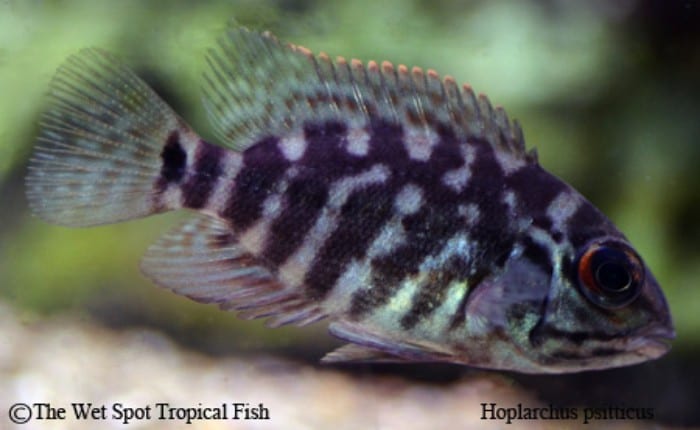Bird in the Hand
Bird in the Hand
To our valued customers,
The Wet Spot is excited to announce the new track we are going down this month. Effective immediately, we are turning our operation into an aviary, rearing rare, tropical birds. April fools! We love our fish too much to turn away from them now! Especially when the variety and diversity of fish characteristics resemble and rival those of all other animals on Earth, including birds. There are fish with beaks, beautiful feather-like spines, bold color patterns, and unique pair-bonding behaviors for rearing young. Who needs birds? Our favorite ave-resembling pisces include Apistogramma cacatuoides, Hoplarchus psittacus, and Macrognathus siamensis.
Scientific NameApistogramma cacatuoides
Common NameCockatoo Apisto
Temperature / pH71 to 84°F / 5.0 to 6.0 pH
Native LocationPeru
Preferred DietSmall invertebrates
More commonly known as the Cockatoo Cichlid, A. cacatuoides gracefully flies through the water in flashes of color. While their namesakes, cockatoos, are found inhabiting tropical islands of Australasia, our Cockatoo Cichlids are widespread throughout the upper Amazon River basin throughout Peru and Brazil. These fish are most commonly found inhabiting slow moving tributaries, backwater habitats, with tannin-stained waters from leaf litter and significant microbial colonies. In captivity, tanks should include plentiful hiding places including aquatic plants, driftwood, branch tangles, rocks, caves, and any other furnishing along with dim lighting. Substrate should be made up of soft sand with dried leaf litter. Like their bird friends, these fish appreciate foliage, and leaves should be allowed to break down fully in the tank, and replaced every few weeks. Reaching up to 3 inches in length, these apistos have a dark black line down their bodies spiny dorsal fins that resemble feathered crests. Populations of this species inhabiting separate habitat pockets show marked differences in coloration. The Wet Spot offers “Super Reds” with bright red and black-spotted fanning and exaggerated fins, “Orange Flash” with tangerine-colored fins and lemon-yellow bodies, and “Peru” with sunset-like fading yellow and purple bodies with pale, and dark-striped fins. Cockatoo Cichlids are carnivorous, and should be offered regular meals of live and frozen fare to supplement high quality meaty pellets. Tank waters should be maintained with temperatures between 71 and 84°F, pH of 5.0 to 6.0, and hardness of 0 to 268 ppm.
Scientific NameHoplarchus psitticus
Common NameParrot Cichlid
Temperature / pH77 to 86°F / 5.5 to 6.5 pH
Native LocationAmazon basin
Preferred DietCarnivorous
Another tropical cichlid inhabiting the Amazon River basin, resembling yet another tropical bird, is H. psittacus. More commonly known as the “True Parrot Cichlid”, can reach up to 12 inches in length with shiny green marbled patterning over light pink bodies. These cichlids require a decent amount of swimming space with minimum tank size of 80 gallons per individual, and while peaceful with conspecifics, they can be aggressive toward smaller species. Tanks should be setup with backwater habitat biome, soft substrate, dim lighting, driftwood, leaf litter, branches, and plants. These beauties are for aquarists with more experience keeping large specimens, though the bond formed with these cichlids is more like raising a dog, as they live up to 10 years in captivity. Mostly carnivorous in the wild, these fish can be fed regular live and frozen meaty meals supplementing high quality cichlid pellets, in addition to occasional vegetal meals of zucchini or spinach. Waters should be maintained with temperatures between 77 and 86°F, pH of 5.5 to 6.5, and hardness of 35 to 214 ppm.
Scientific NameMacrognathus siamensis
Common NamePeacock Eel
Temperature / pH73 to 79°F / 6.5 to 7.5 pH
Native LocationSoutheast Asia
Preferred DietSmall invertebrates
Everyone’s favorite flightless bird, the peacock is not known for its maneuverability, but rather beautiful displays of eye-spotted tails. M. siamensis, however, has the best of both worlds. Known as the “Peacock Eel”, these freshwater fish have long and motile bodies lined by beautiful eye-spot patterns. Reaching up to 11 inches in length, these eels are found at bottom depths of slow-moving or standing waters of Southeast Asia. Most often observed buried in soft sand with only eyes exposed, these fish are nocturnal predators of insect larvae, crustaceans, and worms. Relatively unfussy, and hardy fish, Peacock Eels should be provided soft substrate, dim lighting, and some hiding places in rocks, caves, or branches. Regular evening meaty meals of prawns, mussels, bloodworm, or earthworms should be provided, as dried foods are often snubbed. Optimal waters would have temperatures of 73 to 79°F, pH of 6.5 to 7.5, and hardness of 90 to 267 ppm.
Birds make great pets, though they are often loud, messy, needy, and are even known to fly away. Fish on the other hand, when cared for properly, are none of the fuss, with all of the beauty and soaring grace. Call the Wet Spot today to learn about which bird-like fish suits you best!


